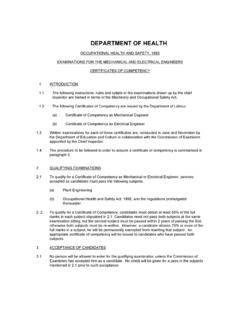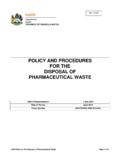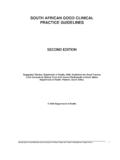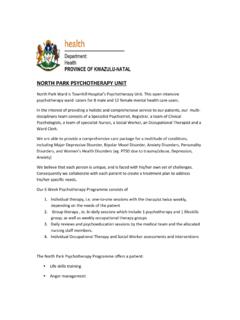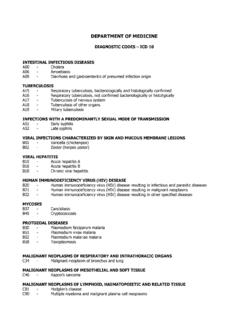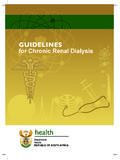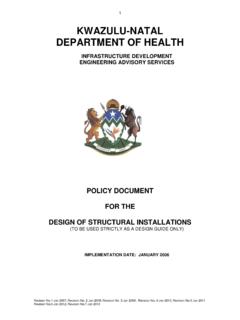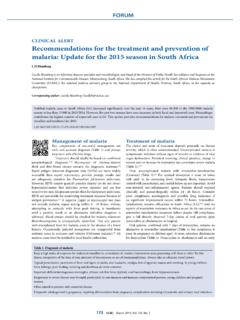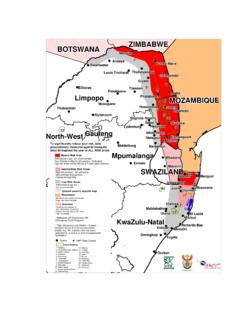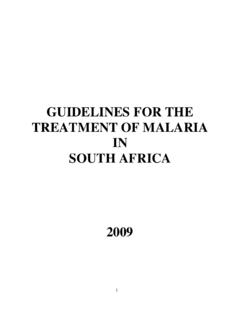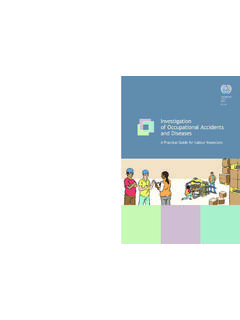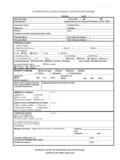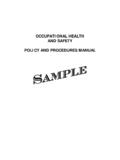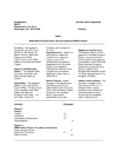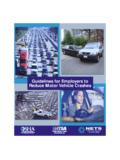Transcription of Occupational Health services for Health Care …
1 A guideline booklet for OH services Page 1. OH services . FOR. Health care . WORKERS. IN THE. NATIONAL Health SERVICE OF SOUTH. AFRICA. A GUIDELINE BOOKLET. DEAPARTMENT OF Health May 2003. A guideline booklet for OH services Page 2. CONTENTS. Foreword 4. Acknowledgements 4. Responsibility 4. Introduction 6. 1. BACKGROUND. 6. 2. ESTABLISHING AN Occupational Health SERVICE 8. Definition 8. What should be included in the programme? 9. Why an OH service is needed for Health care workers 10. Check-List for establishing OH services and indictors 10. 3. ADVANTAGES OF PROVIDING A WELL MANAGED. Occupational Health SERVICE 12. 4. ELEMENTS OF AN Occupational Health SERVICE 12. Promotion of wellness and prevention of Occupational injuries and diseases 12. Clinical 12. Occupational Hygiene 13. Consultative 13. Administrative 13. Research 13. Special Programmes 13. DEAPARTMENT OF Health May 2003. A guideline booklet for OH services Page 3. 5. OCCUPATIONA Health SERVICE ACTIVITIES IN DETAIL 14.
2 Employee medical surveillance - principal purposes 14. Pre-placement screening - complementing the appointment process 14. Pre-placement screening - the responsibilities of those involved 15. Monitoring staff sickness absence and working to reduce it 15. Assessing hazardous exposures in the workplace 18. Management of Occupational injuries and diseases and Non- Occupational injuries and diseases 18. The role of first aid trained personnel 19. The role of Occupational Health services in disaster management 19. Reporting and recording of Occupational injuries and diseases 19. Incident investigation 19. Comprehensive preventative programmes 20. Maintaining Health surveillance programmes 22. Access to employee assistance programmes 23. Promoting Health and Safety issues 23. Promoting wellness in the workplace 24. Identifying hazards and conducting risk assessments 25. 6. PERSONNEL Health RECORDS. Purpose of the Health records 26. Creation and maintenance of records 26. Storage and security of records 27.
3 Access to records 27. Ownership and retention of records 27. 7. AUDITING Occupational Health services 28. Benefits to the organization of auditing the OH service 28. Benefits to the OH service of an audit process 28. The audit cycle 28. Selecting suitable audit measures 28. DEAPARTMENT OF Health May 2003. A guideline booklet for OH services Page 4. LIST OF ANNEXURES. Page Annex A Pre-placement screening - flow chart 33. Annex B Health Questionnaire- periodic,Transfer, and Exit medical 35. Annex C Baseline Health Assessment 36. Annex D Sickness absence monitoring system - flow chart 38. Annex E Management of short-term sickness absence - flow chart 41. Annex F Management of long-term sickness absence - flow chart 43. Annex G Guidelines for managers on sickness absence referral 44. Annex H General Guidelines on sick leave management 45. Annex I Referral for assessment of fitness to work - proforma 46. Annex J Information for managers on sickness absence 47. Annex K Health assessment report - proforma 49.
4 Annex L Immunisation record card 50. Annex M Factors to be considered in a moving and handling assessment 51. Annex N Moving and handling assessment - flow chart 52. Annex O Moving and handling training programme 53. Annex P Stress awareness training programme 54. Annex Q Setting up a Health promotion programme 55. Annex R Checklist of common hazards in Health service premises 56. Annex S Employee Health records - function, content and completion 57. Annex T VDU and workstation training programme (incl. posture diagram.) 59. DEAPARTMENT OF Health May 2003. A guideline booklet for OH services Page 5. Foreword The origin of this guideline booklet was a Know How Fund study into the development of Occupational Health facilities for Health service staff in the public sector. The study arose from a perception that Health service staff should have available sound Occupational Health services to support them as they strive to provide high standards of patient/client care . One of the outcomes of the study, was the suggestion for a booklet that Occupational Health practitioners could use as a resource to guide the development of their local services .
5 The result has been the production of this manual. Acknowledgements This booklet is based very substantially on material contributed by: 1. Christine Hunter, Occupational Health Service Manager, UK, 2. Gopolang Sekobe, Chief Director, Non-Personal Health services , National Department of Health (DoH), 3. Provincial OH Programme Managers/Coordinators: Vuma Khoza (Gauteng); Nosisa Maninjwa (Eastern Cape); Christine van Wyk (Western Cape); Mpho Mabogola (Northern Cape); Isabel Sekgothe (National Office). 4. Representatives of Mpumalanga, Limpopo, North West, Free State, Northern Cape Provinces, and National Centre made contributions to the final draft for Occupational Health . 5 Ian Beach, the Know How Fund Technical Co-ordinator, for assembling the initial draft. The following sponsors are also acknowledged for their support: 1. The Know How Fund of the Department for International Development of the UK Government;. 2. The Technical Cooperation Programme on Occupational Health .
6 Responsibility The task team of the South African Department of Health , who finalised it, accepts the responsibility for the final draft of this document. DEAPARTMENT OF Health May 2003. A guideline booklet for OH services Page 6. PURPOSE OF GUIDELINES. It has become necessary to develop these guidelines for the provision of OH. services by the Department of Health as part of its Health service responsibilities to the public, and especially to its own personnel. The key strategy for OH service delivery is through OH units attached to public Health facilities. This guidelines document addresses the breadth of responsibility of OH services . These guidelines comprise: Part 1 OH services for Health care Workers within the Department of Health Part 2 Medical surveillance (Monitoring of Respiratory Health ) of Ex-Miners Part 3 OH services for other Government Departments and the general public. Introduction The World Health Organisation/ILO defines Occupational Health as being to promote and maintain the physical, mental and social well-being of all workers, and not merely the absence of disease.
7 As such, Occupational Health deals with the impact of work on Health and Health on work. Since 1999 it has become necessary to develop guidelines for the provision of Occupational Health services in the Department of Health as part of Health service responsibilities for Public Health services , including its own personnel. Key strategy for OH service delivery for the Department of H is through OH units attached to Provincial Health facilities. The DoH and Provincial Health Departments are currently engaged in developing OH services as fast as it is practicable to do so. The challenges of availability of resources can best be met by integrating OH services with other programmes to achieve efficiency, economy, and equity. Policies are in place and service frameworks continue to be developed. Training of OH practitioners must continuously be expanded to meet service needs. Most encouraging of all, OH units are increasingly playing their part in the provision of OH services .
8 This booklet has been produced to help all those involved in provision of OH. services for Health care workers. Based on international good practice, it contains practical suggestions that can be used as models in developing the service further. As such it compliments the current and completed policy and planning work. DEAPARTMENT OF Health May 2003. A guideline booklet for OH services Page 7. 1. BACKGROUND. Erasmus Commission of Inquiry 1974. The Commission found many inadequacies in the provision of Health services in industry. These covered areas of hazardous exposure; lack of statistics regarding environment, state of Health of the workers and the nature of diseases; and inadequate rehabilitation of workers affected by Occupational diseases. It further revealed that the state of legislation affecting Occupational Health was grossly deficient, grossly duplicated (12 separate Government Departments involved), and that 71% of workers were not covered by legislation.
9 No single body was responsible and the ability to change the legislation was hampered by the slowest departments. This inquiry resulted in the passing of the Machinery &. Occupational Safety Act in 1983. Occupational Health and Safety Act An Act of Parliament was passed in 1993 the Occupational Health & Safety Act (Act. No. 85 of 1993). This legislation provides for more protection for employees as well as responsibilities of the employer to ensure that the workplace is safe and healthy. Whilst it covers the roles and responsibilities of employers and employees, it also covers the roles and responsibilities of Health and safety representatives. Compensation for Occupational Injuries & Diseases Act. COID Act also passed in 1993, Act No. 130 of 1993, replaced the Workmen's Compensation Act. This Act provides for compensation to workers who have sustained an injury on duty, or who have contracted an Occupational disease. Exempted from the Act are Domestic Workers in private households, and members of the South African National Defence Force, and the South African Police.
10 The Abdullah Report The Abdullah Report of January 1996, reports on the investigation into Occupational Health services in South Africa. It covers the legislation and statutory agencies dealing with Occupational Health in South Africa; profiles on Occupational injuries and diseases and services provided; issues such as human resources, information systems and research, as well as proposals for a coherent Occupational Health and safety system, and the role of the Department of Health at National, Provincial, and District levels. DEAPARTMENT OF Health May 2003. A guideline booklet for OH services Page 8. Mine Health & Safety Act 1996. This legislation was promulgated to protect the Health and safety of persons at mines by making provision for effective monitoring of conditions and enforcement of Health and safety measures. It also facilitates the promotion of training in Health and safety, as well as cooperation and consultation between State, Employers, Employees and their representatives.
